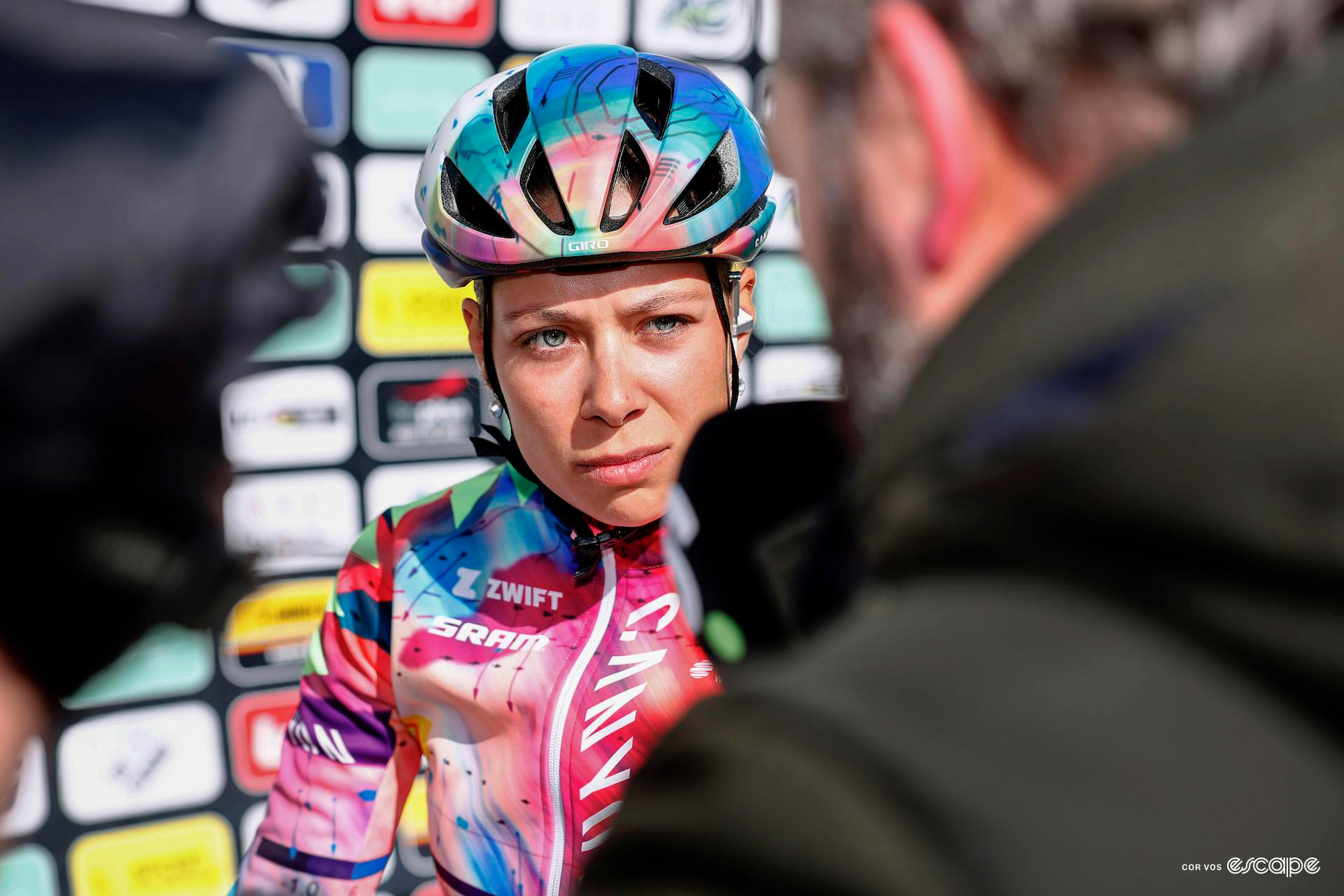Canyon-SRAM released a statement Sunday morning announcing the provisional withdrawal of Belgian road and track rider Shari Bossuyt after the rider tested positive for a substance on the World Anti-Doping Agency’s prohibited list.
The 22-year-old tested positive for Letrozole after an anti-doping control following her stage 3 victory at the Tour de Normandie Féminin on 19th March 2023. Letrozole is a breast cancer medicine that has a similar effect on the body as testosterone by essentially encouraging the growth of muscle mass.
“In the medical field, letrozole is mainly used in people undergoing post-cancer treatment,” toxicologist Jan Tytgat (KU Leuven), told Het Nieuwsblad. “Women with breast cancer who were first treated with chemotherapy are then given letrozole, for example, to get their hormone balance in order. So it is indeed a medically responsible remedy.”
Canyon-SRAM was notified after both Bossuyt’s A and B samples were shown to contain Bis-(4-cyanopheny)methanol, Metabolite of Letrozole, and though its ‘specified substance’ categorisation does not mandate a suspension, the rider has been made “provisionally non-active” under the team’s own anti-doping rules while she awaits a decision by the French Anti-Doping Agency, which carried out the test in Normandy. In the meantime, Bossuyt and her manager are holding a press conference on Monday (5th June).
It’s not the first time Letrozole has been in the cycling news. Toon Aerts tested positive for the same in 2022 and was handed a two-year suspension, but having asserted the result was due to contamination, the Belgian cyclocross pro is continuing to fight the case.
On hearing the news of Bossuyt’s situation, Aerts made his own response on social media.
“We are one year later. And I’m still deep in misery,” Aerts wrote. “Then there is another case. I can well imagine what Shari is going through now. This shouldn’t happen. Another athlete, who is also human, who will go through a deep valley with her whole family. Without having done anything wrong!
“My emotions have turned to a kind of anger lately, although I try not to get too worked up about it. I’ve done everything I can to prove my innocence, but I can’t get much further. The days are ticking away, every day that passes is a step. The days go slowly, too slow. I still have no idea of my future as a person and a rider.”
Aerts continues to assert his innocence, indicating in his statement that his and Bossuyt’s may not be isolated cases, and that there may be more unknowingly contaminated riders.
“No two without three is the saying,” he writes. “I fear there will be many more victims. I hope that authorities will now also face the problem and gather more information about what is happening to us now. Don’t let all this be in vain and take action so that there are no more victims.”
As well as earning her place as a versatile Classics rider, Bossuyt is a seasoned track racer and last year became Madison world champion with partner Lotte Kopecky, putting her firmly in contention for the 2024 Paris Olympics. However, if the young Belgian were to receive the same suspension as compatriot Aerts, she would be ruled out of competition until March 2025.
Belgian newspaper has since reported that both Aerts and Bossuyt had registered very small quantities of the substance, Aerts showing 2.4 nanograms per ml and Bossuyt showing half that. This, according to toxicologist Tytgat, could “certainly” imply accidental intake via contamination, as Aerts has repeatedly claimed as he continues to fight his suspension.
“WADA applies a threshold value of 20 nanograms per milliliter for many products,” Tytgat said. “With everything that remains below that, you can ask yourself whether it can have a performance-enhancing effect.”
So while there is an upper threshold for Letrozole, no lower limit has been specified, so any trace at all, however minimal, will be picked up and registered as an anti-doping infraction per WADA, regardless of its negligible possible effect.
Where this story gets really interesting is a further link between the two Belgian’s situations. Bossuyt’s sample was taken after she won a stage in Normandy, but the curious detail finds its home the day before. The Canyon-SRAM rider came second on stage 2 into Flamanville, the very same place where Aerts tested positive 14 months earlier.
Tytgat went on to explain that Letrozole is often used in livestock farming, and as well as its nuclear power plant, Flamanville is known for its population of cows.
“Letrozole is one of those substances that can be measured very sensitively in the urine of an athlete,” the toxicologist said, offering a warning that the substance can sometimes appear in dietary supplements and athletes should therefore be wary of what they take in. “It can therefore be detected even if it were present in very small concentrations of cow’s milk or meat. The same goes for clenbuterol, by the way, for those who still remember the Contador case. There used to be no lower limit for this either, but when it turned out that the substance could indeed be found in contaminated meat, WADA nevertheless set a threshold for this.
“Incidentally, it is often the case that the anti-doping agency is stricter than the European regulations on nutrition. So I think it would be very useful to investigate what the real situation was here, because if people who play sports professionally are no longer allowed to eat, what are we doing?”
After her press conference on Monday, Bossuyt is likely to be subject to hair analysis which can yield more fruitful data than a urine sample. You might remember that Aerts grew out his hair following his positive test to maximise the possibility of gaining answers.
Update (Monday June 5)
At her press conference on Monday, Bossuyt issued the following statement:
“At the moment the procedure is still ongoing and I have to go to the AFLD [the French anti-doping agency] and explain how the product got into my body. Something that turns out to be extremely difficult today since I have never come into contact with Letrozole and have never consciously used it. In fact, this was the first time I had heard of Letrozole. Fortunately, I am currently well supported. I hope we can clarify soon. But above all: that we can prove that we are not cheaters. In consultation with the team, I have decided not to race in the coming weeks. Mainly because my head isn’t in it. Everything indicates that we are dealing with a contamination. That is why I would like to appeal to all authorities that we may be dealing with an underlying problem. I will continue to train so that I can compete again soon.”
Bossuyt’s manager, Yannick Prevost, who is also the manager of Toon Aerts, provided an additional statement at the editorial offices of Belgian newspaper Het Laatste Nieuws.
“Shari is not a doping user. She is 22 years old and has been known to the federation for years. She was picked up by the talent detection program of the union, she has been closely monitored for years, she follows a very beautiful and natural evolution as a rider. She also wants to play the game fairly herself. We have no doubts about her: there was something in her body, but this is not intentional doping use.”
What did you think of this story?

